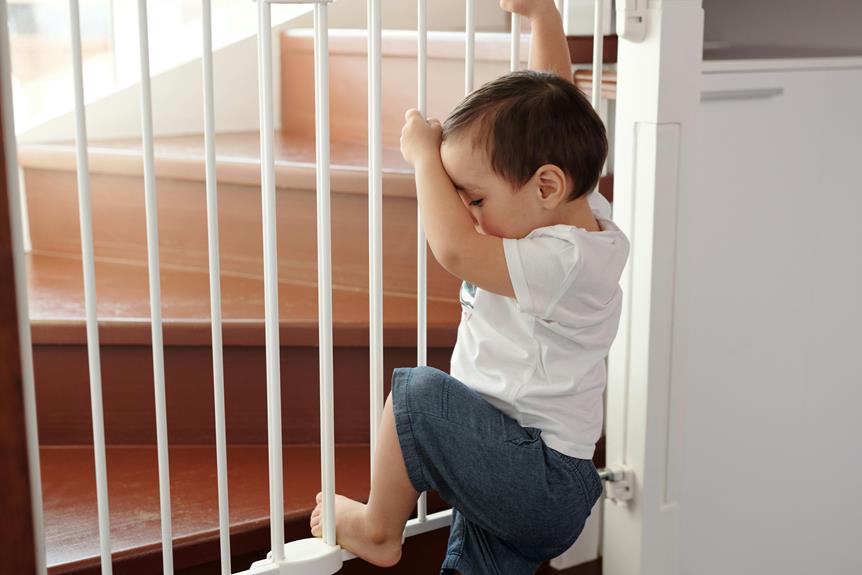To baby-proof your home for safety, install sturdy safety gates at staircases and hazardous areas, ensure furniture and appliances are anchored securely to walls, use protective covers on electrical outlets, store hazardous substances in locked cabinets with childproof locks, and secure windows and doors with appropriate locks to prevent falls and keep out of reach. Taking these essential steps will help you create a safer environment for your little one.
Safety Gates Installation
To ensure the safety of your little one, installing safety gates at key areas in your home is crucial. Safety gates are essential for blocking off staircases, doorways, and other potentially hazardous areas. When choosing safety gates, opt for ones that are sturdy and securely fasten to the walls or door frames. Make sure the gates are installed correctly and are the appropriate height to prevent your child from climbing over them.
Position safety gates at the top and bottom of staircases to prevent falls. Additionally, use gates to block access to rooms with potential dangers such as the kitchen, where hot surfaces, sharp objects, and chemicals are present. Remember to check the gates regularly to ensure they're still securely in place and functioning correctly.
Furniture and Appliance Anchoring
Anchoring furniture and appliances is crucial for ensuring the safety of your home and your little one. Securing large items like bookshelves, dressers, and televisions to the wall can prevent them from toppling over and causing serious injuries. Use furniture straps or brackets to anchor these items securely.
When anchoring furniture, make sure to follow the manufacturer's instructions carefully. Locate wall studs for the most secure attachment and use appropriate hardware for the job. Regularly check the anchoring devices to ensure they're still in good condition and tighten them if needed.
For appliances like stoves, refrigerators, and dishwashers, anchoring helps prevent tipping or accidental access. Use appliance straps or brackets to secure these items in place. Make sure that cords are out of reach and not dangling where a child could pull on them.
Taking the time to anchor your furniture and appliances can give you peace of mind knowing that your home is a safer place for your little one to explore.
Electrical Outlet Covers
When ensuring the safety of your home and little one, one important aspect to consider is securing electrical outlet covers. Children are naturally curious and love to explore, making electrical outlets a potential hazard. Installing outlet covers is a simple yet effective way to prevent your child from inserting objects into the sockets, reducing the risk of electric shock.
Outlet covers come in various designs, including sliding covers, plug covers, and complete outlet cover plates. Choose covers that are sturdy and can't be easily removed by small hands. It's essential to cover all outlets within your child's reach, including those behind furniture or in less frequented areas.
Regularly check the outlet covers for any signs of wear or damage and replace them as needed. Additionally, teach your child about electrical safety as they grow older to further reduce the risk of accidents.
Hazardous Substance Locks
Securing hazardous substance locks is crucial in safeguarding your home and protecting your child from potential dangers. Household cleaners, medications, and other chemicals can pose serious risks to a curious child. To prevent accidental ingestion or exposure, ensure that all hazardous substances are stored in locked cabinets or drawers. Invest in childproof locks specifically designed to keep these items out of your child's reach.
When choosing locks for hazardous substances, opt for ones that are sturdy and require a complex series of movements to open. This will deter even the most determined of toddlers. Remember to keep the keys to these locks in a secure place that's inaccessible to your child, but still easily accessible to you in case of emergencies.
Regularly check that the locks are in proper working condition and that there are no signs of wear or damage. Additionally, educate yourself on the potential hazards of common household substances and always follow proper storage guidelines to further reduce the risk of accidents. By taking these precautions, you can create a safer environment for your child to explore and grow.
Window and Door Locks
For added safety at home, make sure to check the locks on your windows and doors regularly. Secure window locks are essential to prevent children from opening windows and risking falls. Consider installing window guards or stops for added protection. Door locks should be out of reach of children to prevent them from wandering outside unsupervised. Deadbolt locks are more secure than basic locksets and can help prevent unauthorized entry. Make it a habit to double-check that all windows and doors are locked before leaving the house or going to bed. Additionally, consider installing door alarms that sound when a door is opened, alerting you to potential risks.
Regular maintenance of window and door locks is crucial for ensuring your child's safety at home. Inspect locks for any signs of wear or damage, and promptly repair or replace them as needed. By staying vigilant and proactive in maintaining secure window and door locks, you can create a safer environment for your little one to explore and play without unnecessary risks.

